

Wacky Winter Weather |
|||
Across much of the United States, the 1999-2000 winter has produced some unusual weather patterns. For instance, the Pacific Northwest has already received record amounts of precipitation while, until the winter storms in late January, the mid-Atlantic region had received very low amounts. "Our winter weather pattern is being influenced by La Niña,"
Uccellini observes. "This is characterized by a strong flow of air from
Canada over the Great Lakes region and toward the mid-Atlantic. That is a known
factor influencing our winter weather patterns; it was expected and incorporated
into the winter weather forecasts." |
|||
 In general, says Jones, La Niña causes wintertime temperatures to be higher than average so we are more likely to get more rain or ice storms, such as the one that occurred along the East Coast on Superbowl Sunday. This winter has certainly been milder than average and, up until the winter bomb, precipitation amounts have been lower than average. As a matter of fact, until the Jan. 24-25 snowstorm, Washington, D.C., had experienced only two snowfalls of 6 inches or more during a La Niña winter. By now, most people are only too familiar with the El Niño/La Niña climate phenomena, thanks to all the negative press these climatic siblings receive. But Uccellini says there is another strong influence on weather patterns in the northeastern U.S. that many people haven’t yet heard of–the North Atlantic Oscillation (or NAO). It is a distant cousin to the El Niño/La Niña Pacific oscillation. (Stay tuned, a case study on the North Atlantic Oscillation will appear in the Earth Observatory later this month.) "When we (the National Weather Service) issued our winter forecast in November 1999," Uccellini recalls, "we said that the NAO would be the wild card for the northeastern U.S." In January, the NAO caused a build-up of very cold air over Greenland and southeastern Canada. This has had two effects on weather in the United States: (1) it became a source of frigid air filtering down into New England, causing temperatures there to plummet, and (2) it provided the colder temperatures needed to turn rain into sleet and snow. "We do look to the Pacific Ocean as a basis for our winter forecasts," Uccellini says, "but we also look at what’s happening in the Atlantic. We still have a lot of research to do because we don’t have a complete understanding of how these large-scale ocean-atmosphere phenomena work." Jones adds that it is too soon to tell what scientists have learned from this wacky winter weather. He says it will probably take years, and more data, before they learn lessons that meteorologists can apply toward improving their models. Reference: Uccellini, Louis W., Paul J. Kocin, and Joseph M. Sienkiewicz, 1994: "Advances in Forecasting Extratropical Cyclogenesis at the National Meteorological Center," from Proceedings of of the Geophysical Institute's International Symposium at the University of Bergen, Norway. Edited by Sigbjorn Gronas and Melvyn A. Shapiro; published by the American Meteorological Society, pp. 259-274. |
A mild La Niña (colder than normal sea surface temperatures in the equatorial Pacific,
see the La Niña fact sheet.)
persisted throughout the winter of 1999—2000. Typically, La Niña causes mild
winters along the U.S. Atlantic coast. Storms tend to bring rain or sleet rather than snow.
This image shows an exaggerated topography of the equatorial Pacific region where height corresponds to the difference in sea surface height from normal. Color corresponds to the difference in sea surface temperature from normal. (Image by Greg Shirah, NASA GSFC Scientific Visualization Studio) | ||